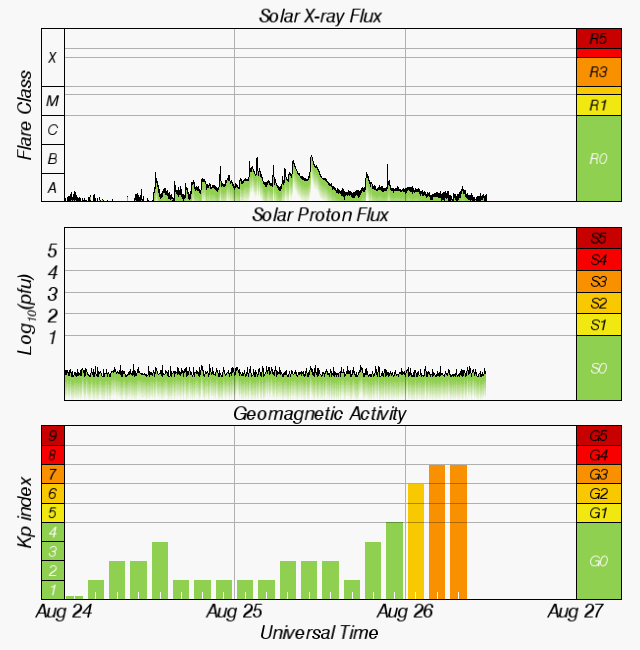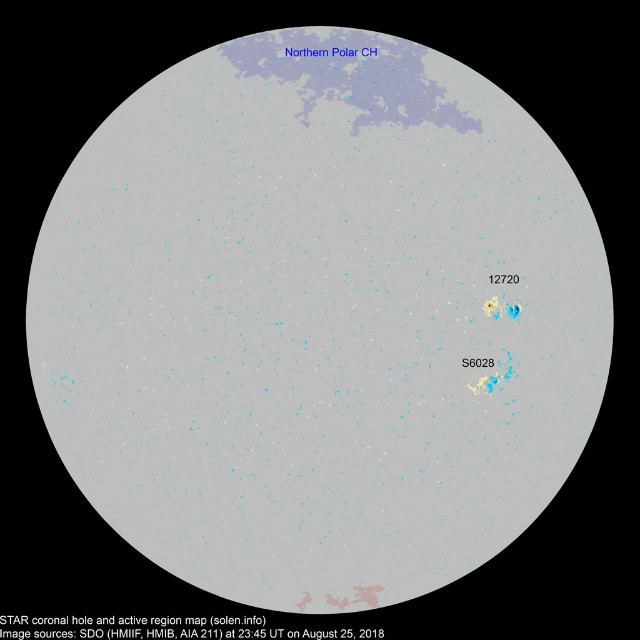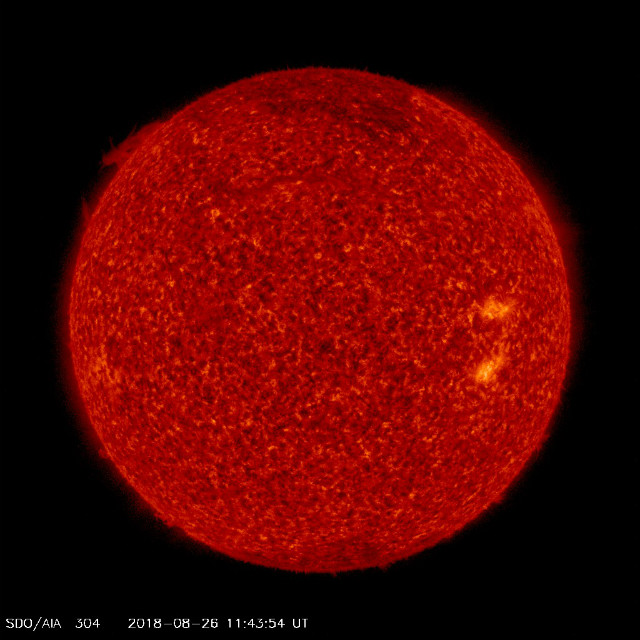CME sparks G3 Strong geomagnetic storm; reverse polarity sunspot appears on the Sun

G3 Strong geomagnetic storm levels associated with the passage of slow-moving August 20th Coronal Mass Ejection were observed early August 26, 2018.
A faint and slow-moving CME was first seen in LASCO coronagraph imagery at approximately 22:00 UTC on August 20. The source for this CME is unclear, SWPC forecasters said August 21, calling for a glancing blow and negligible impact due to CME's lack of density and slow nature.
Geomagnetic K-index of 4 threshold was reached at 21:43 UTC on August 25, followed by K-index of 5 (G1 Minor) at 01:54 UTC on August 26, K-index of 6 (G2 Moderate) at 02:57 and K-index of 7 (G3 Strong) at 05:59 and 07:38 UTC.

G3 Strong geomagnetic storm potential impacts:
Area of impact primarily poleward of 50 degrees Geomagnetic Latitude.
Induced Currents – Power system voltage irregularities possible, false alarms may be triggered on some protection devices.
Spacecraft – Systems may experience surface charging; increased drag on low Earth-orbit satellites and orientation problems may occur.
Navigation – Intermittent satellite navigation (GPS) problems, including loss-of-lock and increased range error may occur.
Radio – HF (high frequency) radio may be intermittent. Aurora – Aurora may be seen as low as Pennsylvania to Iowa to Oregon.

Taken by John McKinnon on August 26, 2018 @ Four Mile Lake, Alberta, Canada. Via SpaceWeather.com
The level of disturbance this CME caused just a couple of hours after its arrival is not surprising if you take into account the current state of our weakened geomagnetic field.

There is an interesting new sunspot on the Earth-side of the Sun, AR 2720 numbered on August 24.
The magnetic polarity of this region is reversed, its north and south ends are backward compared to the polarity of normal sunspots in the current solar cycle (SC24).
"Could this be the first big sunspot of the next solar cycle, popping up now in the middle of solar minimum?" Dr. Tony Phillips of SpaceWeather noted.

Solar activity was very low over the past 24 hours and is expected to remain at those levels, with a slight chance for C-class flare activity, over the next three days.
Reverse polarity Region 2720 (N08W39, Dao/beta) exhibited consolidation in its trailer spot while producing multiple B-class enhancements over the past 24 hours. Region 2719 (S06W36, Cro/beta) continued to decay. No Earth-directed CMEs were observed in available coronagraph imagery.
The greater than 2 MeV electron flux reached high levels, with a peak flux of 1 930 pfu observed at 18:50 UTC on August 25. The greater than 10 MeV proton flux was steady at background levels.
Featured image taken by John McKinnon on August 26, 2018 @ Four Mile Lake, Alberta, Canada. Via SpaceWeather.com

Omg! I’m not even a scientist but this is not looking too good.
“Could this be the first big sunspot of the next solar cycle, popping up now in the middle of solar minimum?” Dr. Tony Phillips of SpaceWeather noted.
I’m surprised you quoted this inane comment. We’re still about a year ahead of NASA’a prediction for the start of the solar minimum for Solar Cycle 24 and this guy is talking about the next solar cycle. It’s the most asinine comment I’ve ever read on spaceweather.coim.
On the other hand, what just happened? A very substantial CME was launched and NASA could not explain its origin, a reverse polarity sunspot is discovered, record-breaking ground currents were recorded, the surprising intense CME predictably triggered a 7.1 earthquake, and there was (as far as I know) a never before seen jump of almost 5% in galactic cosmic rays over a mere eight hours. Of course, the latter never made the news. They never do.
What just happened? Wow! I see stuff like this and then look at our front pages and all I can think is panem et circenses. The curtain is rising on a level of GCR flux not seen in perhaps thousands of years and only a handful of people are paying attention.